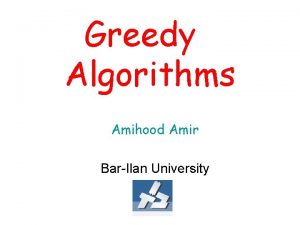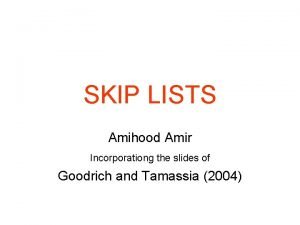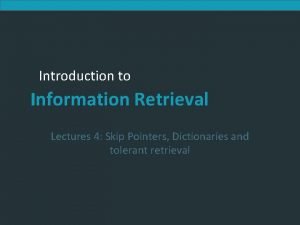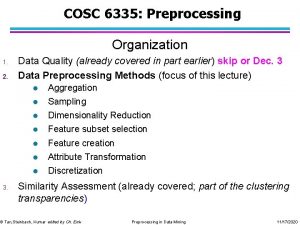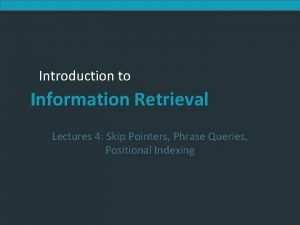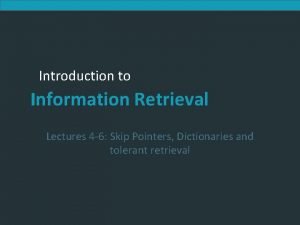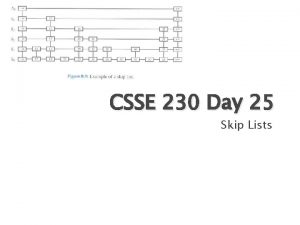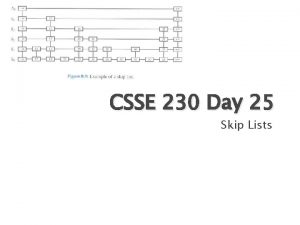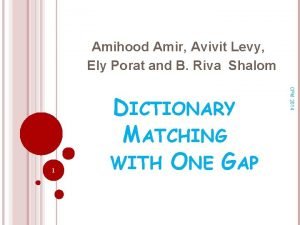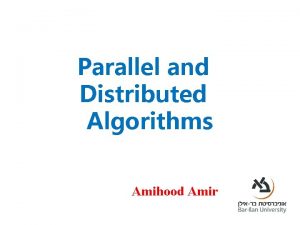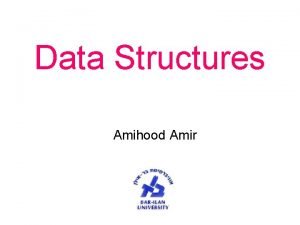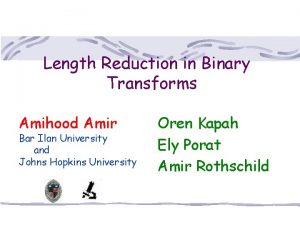SKIP LISTS Amihood Amir Incorporationg the slides of














- Slides: 14

SKIP LISTS Amihood Amir Incorporationg the slides of Goodrich and Tamassia (2004)

Sorted Linked List Search Time: The effect is that of a binary search. So search time is: O(log n). S 3 - S 2 - S 1 - S 0 - 31 23 12 23 44 31 26 31 34 44 56 64 + 64 78 +

What about Space? Solution: lists (Bill 2000) Problem: Skip Insertions and. Pugh deletions

What is a Skip List • A skip list for a set S of distinct (key, element) items is a series of lists S 0, S 1 , … , Sh such that – Each list Si contains the special keys + and - – List S 0 contains the keys of S in nondecreasing order – Each list is a subsequence of the previous one, i. e. , S 0 S 1 … Sh – List Sh contains only the two special keys • We show to use a skip list to implement the dictionary ADT S 3 - S 2 - S 1 - S 0 - + + 31 23 12 © 2004 Goodrich Tamassia 23 26 31 34 + 64 44 56 64 78 +

Search • We search for a key x in a a skip list as follows: – We start at the first position of the top list – At the current position p, we compare x with y key(next(p)) x = y: we return element(next(p)) x > y: we “scan forward” x < y: we “drop down” – If we try to drop down past the bottom list, we return null • Example: search for 78 S 3 - S 2 - S 1 - S 0 - + + 31 23 12 © 2004 Goodrich Tamassia 23 26 31 34 + 64 44 56 64 78 +

Randomized Algorithms Coin tossing עץ או פלאי ישראל או פרוטה Heads or Tails

Randomized Algorithms • A randomized algorithm performs coin tosses (i. e. , uses random bits) to control its execution • It contains statements of the type b random() if b = 0 do A … else { b = 1} do B … • Its running time depends on the outcomes of the coin tosses © 2004 Goodrich Tamassia • We analyze the expected running time of a randomized algorithm under the following assumptions – the coins are unbiased, and – the coin tosses are independent • The worst-case running time of a randomized algorithm is often large but has very low probability (e. g. , it occurs when all the coin tosses give “heads”) • We use a randomized algorithm to insert items into a skip list

Insertion • To insert an entry (x, o) into a skip list, we use a randomized algorithm: – We repeatedly toss a coin until we get tails, and we denote with i the number of times the coin came up heads – If i h, we add to the skip list new lists Sh+1, … , Si +1, each containing only the two special keys – We search for x in the skip list and find the positions p 0, p 1 , …, pi of the items with largest key less than x in each list S 0, S 1, … , Si – For j 0, …, i, we insert item (x, o) into list Sj after position pj • Example: insert key 15, with i = 2 p 2 S 2 - p 1 S 1 - S 0 - p 0 10 23 23 © 2004 Goodrich Tamassia 36 S 3 - + + S 2 - 15 + S 1 - 15 23 + S 0 - 15 23 10 + + 36 +

Deletion • To remove an entry with key x from a skip list, we proceed as follows: – We search for x in the skip list and find the positions p 0, p 1 , …, pi of the items with key x, where position pj is in list Sj – We remove positions p 0, p 1 , …, pi from the lists S 0, S 1, … , Si – We remove all but one list containing only the two special keys • Example: remove key 34 S 3 - p 2 S 2 - 34 S 1 - S 0 - + 12 23 34 © 2004 Goodrich Tamassia p 1 p 0 45 + S 2 - + S 1 - + S 0 - + + 23 12 23 45 +

Space Usage • The space used by a skip list depends on the random bits used by each invocation of the insertion algorithm • We use the following two basic probabilistic facts: Fact 1: The probability of getting i consecutive heads when flipping a coin is 1/2 i Fact 2: If each of n entries is present in a set with probability p, the expected size of the set is np © 2004 Goodrich Tamassia • Consider a skip list with n entries – By Fact 1, we insert an entry in list Si with probability 1/2 i – By Fact 2, the expected size of list Si is n/2 i • The expected number of nodes used by the skip list is • Thus, the expected space usage of a skip list with n items is O(n)

Height • The running time of the search an insertion algorithms is affected by the height h of the skip list • We show that with high probability, a skip list with n items has height O(log n) • We use the following additional probabilistic fact: Fact 3: If each of n events has probability p, the probability that at least one event occurs is at most np © 2004 Goodrich Tamassia • Consider a skip list with n entires – By Fact 1, we insert an entry in list Si with probability 1/2 i – By Fact 3, the probability that list Si has at least one item is at most n/2 i • By picking i = 3 log n, we have that the probability that S 3 log n has at least one entry is at most n/23 log n = n/n 3 = 1/n 2 • Thus a skip list with n entries has height at most 3 log n with probability at least 1 - 1/n 2

Search and Update Times • The search time in a skip list is • When we scan forward in a list, proportional to the destination key does not belong to a higher list – the number of drop-down steps, plus – the number of scan-forward steps • The drop-down steps are bounded by the height of the skip list and thus are O(log n) with high probability • To analyze the scan-forward steps, we use yet another probabilistic fact: Fact 4: The expected number of coin tosses required in order to get tails is 2 © 2004 Goodrich Tamassia – A scan-forward step is associated with a former coin toss that gave tails • By Fact 4, in each list the expected number of scanforward steps is 2 • Thus, the expected number of scan-forward steps is O(log n) • We conclude that a search in a skip list takes O(log n) expected time • The analysis of insertion and deletion gives similar results

Summary • A skip list is a data structure for dictionaries that uses a randomized insertion algorithm • In a skip list with n entries – The expected space used is O(n) – The expected search, insertion and deletion time is O(log n) © 2004 Goodrich Tamassia • Using a more complex probabilistic analysis, one can show that these performance bounds also hold with high probability • Skip lists are fast and simple to implement in practice

Is there a deterministic scheme? Yes! We will see Balanced Trees A deterministic version of skip lists is similar to some balanced trees (2 -3 trees).
 Amihood amir
Amihood amir Skip pointers
Skip pointers Amir slides
Amir slides A small child slides down the four frictionless slides
A small child slides down the four frictionless slides A hockey puck sliding on smooth ice at 4 m/s
A hockey puck sliding on smooth ice at 4 m/s Which is a good idea for using skip pointers
Which is a good idea for using skip pointers Mining skip
Mining skip Skip rochefort
Skip rochefort Scanning and skimming
Scanning and skimming Skip counting number lines
Skip counting number lines Skip coleman
Skip coleman Skip pointers
Skip pointers Skip the games
Skip the games Which is a good idea for using skip pointers
Which is a good idea for using skip pointers Skip through the seasons
Skip through the seasons
